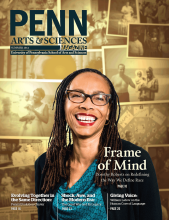How would you decide if damming up the San Francisco Bay would solve the area’s water problems? In the 1950s, the U.S. Army Corps of Engineers built a one-acre model to answer this question, simulating the flow of water in the real Bay using concrete and copper strips. Their answer was no; the water just stagnated and didn’t make the freshwater lakes some had hoped for.
Models—concrete, mathematical, and now computer—are a vital part of research, says Associate Professor of Philosophy Michael Weisberg, author of Simulation and Similarity: Using Models to Understand the World. Unlike the experiments and data-gathering we usually associate with science, though, models aren’t a direct reflection of reality. There is an interpretive step in creating and using any kind of model, so how true can the results be? Why can models be trusted?
Weisberg describes modeling as a kind of surrogate reasoning: To understand a complicated thing, we try to understand something simpler—a model—and then to understand the relationship between the simple thing and the complex thing. Modeling has usually been thought of in terms of direct structure mapping, but Weisberg says this approach doesn’t appreciate the fact that models often must be distorted or incomplete by design. Even using today’s supercomputers, there are restraints on size and cost so that the smallest unit represented in a computer model may cover a three-dimensional space of hundreds of kilometers.
Because of these limitations, Weisberg argues the goal of modeling shouldn’t be a 100-percent-accurate representation of reality. Instead, scientists should try to identify a few important ways in which the model and its target must be similar. Because different modelers have different reasons to make models—to understand a process, to explain mechanics, to make a prediction—each act of model construction will require a different judgment of which features should be included in the model and which should be left out. For example, with the San Francisco Bay project, “I think they would be much more interested in being able to make predictions about the velocity of water than, say, the temperature of the water or the conditions for swimmers,” he says.
“If you ask ‘How good is this model?’—I don’t think that question can be answered without knowing what it is that you want to do with the model,” says Weisberg. “Some models make the best predictions. Some models are highly explanatory. Some models sensitize our imaginations. Science relies on all of these things. That’s the picture I have, and it emphasizes the importance of using many different models to bear down on a problem from different angles.”





